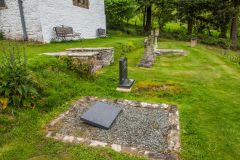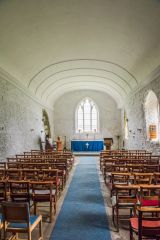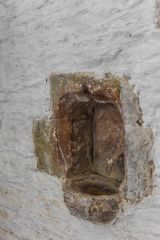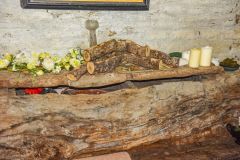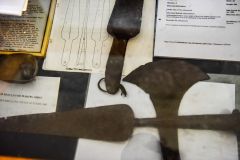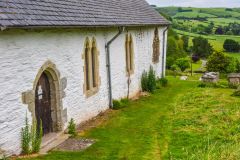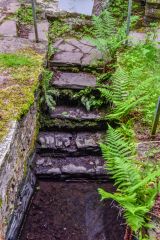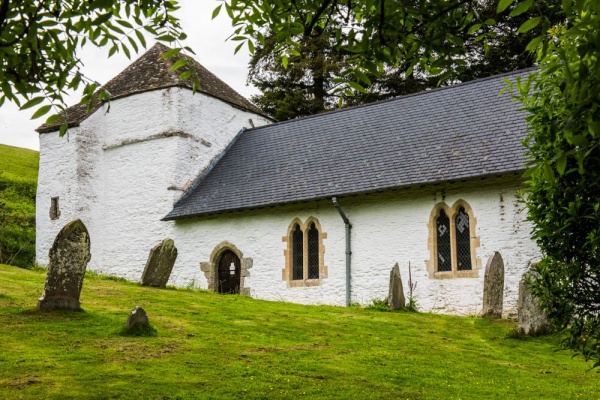
The ancient church at Pilleth stands in an idyllic location on the eastern slope of Bryn Glas, a wooded hillside just south of Knighton. The churchyard looks out over the valley of the River Lugg below.
The name 'Pilleth' comes from the Old English for a 'slope by the pools'. It was recorded in the Domesday Book of 1086 as Pilelei. The church briefly belonged to Llanthony Abbey in Gloucester during the 12th century but for most of its long history has been a chapel of the church of St Cynllo at Llangunllo. The church location on its remote hillside is typical of Celtic sacred sites.
Though the church is dedicated to the Blessed Virgin Mary, a typical Norman dedication, the parish feast day is St Davids Day, suggesting a much earlier Celtic origin.
Pilleth Holy Well
Throughout the medieval period, Pilleth was a destination for pilgrims drawn to the holy well located just north of the tower. The well waters were said to help heal eye diseases. The church also boasted a famous statue of the Virgin Mary, known as Our Lady of Pilleth.
The holy well is a fascinating relic, with stone steps leading down into an immersion pool. The well was originally covered with a stone well-head but this is now gone. Hand-cut stone from the well-head has been recovered from the pool below.
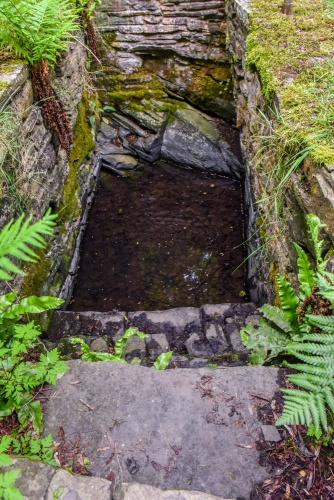
The building itself is 13th century, with a 15th-century tower, made with rough rubble quarried locally. On the north wall of the tower you can see traces of the earlier, larger tower burned by Owain Glyndwr's soldiers in 1402.
The Battle of Pilleth
The church has great significance in Welsh history, for it was here in 1402 that Owain Glyndwr defeated a larger force of English under Sir Edmund Mortimer at the Battle of Pilleth (more commonly known as the Battle of Bryn Glas in Wales). The church was burned by Glyndwr's men in the aftermath of the bloody battle, which raged along the steep hillside above and below the church.
In the churchyard is a mass grave of soldiers and a modern memorial to the fallen of both sides. Inside the church is a small exhibit about the battle and objects found on the battlefield.
The church was rebuilt following the battle but the base of the tower remains from the earlier building.
The Price family of Pilleth Court had a huge influence on St Mary's. Pilleth Court is the large white house at the bottom of the hill, visible from the churchyard.
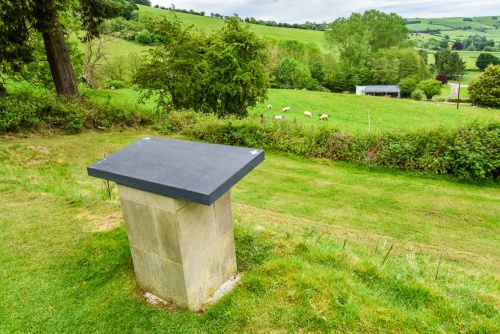
In 1646 Charles Price left money to repair the church and estates near Presteigne to pay for a service and sermon every Ash Wednesday and Good Friday. A descendant, Lady Anna Child, left 500 pounds to establish a school for poor children and money to fund two apprentices a year. The school founded by Lady Child is still active.
A carved rood screen was installed following the 1402 fire, but this was destroyed by a second fire in 1894. It is thought to have been similar to the screen at Llandegley.
The 1894 fire was caused by an iron chimney that overheated and set fire to the roof. The entire building was gutted by the fire, but the pulpit and Jacobean communion table survived. The pulpit is now at nearby Whitton church.
One of the medieval benches also survived the 1894 fire, but it has been moved to Whitton as well, where it can be seen on the south side of the choir stalls.
After the fire the church remained a shell for over a decade until in 1905 a local couple asked a personal friend named Walter Tapper, then a promising architect with the GF Bodley company, to restore the church. This he did, installing a temporary roof that is still in place over 100 years later. Tapper went on to restore the vaulting of the Henry VII Chapel at Westminster Abbey, for which he was created KCVO (Knight Commander of the Royal Victorian Order).
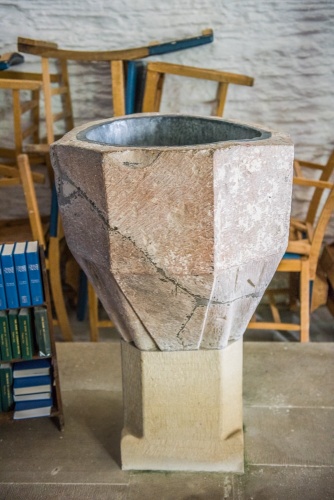
Tapper designed the flight of stone steps leading to the churchyard as well as the unusual circular stone seat with an octagonal 15th-century font in the centre.
He also reinstalled the original hand-cut stone tiles on the tower's saddleback roof and topped it with an old weather vane he discovered lying inside the tower. In the belfry is an original medieval timber bell frame made to hang three bells. Only one bell remains, dated 1450 and dedicated to St Radegunda.
Interior highlights include a 13th-century holy water stoup by the door, and a simply-carved 13th-century font. On the wall is a 16th-century sword, breastplate and spur belonging to one of the Price family of Pilleth Court -probably James Price, whose monument has been moved to Whitton church.
At the west end of the nave is an 18th-century parish chest, while in the choir you can see a pair of Jacobean chairs. The larger chair incorporates a section of a carved pew. A Jacobean communion table is stored in the tower, along with an ancient oak chest made from a single tree trunk.
St Mary's has such a wonderful atmosphere. The combination of the battlefield viewpoint and soldiers' grave, the ancient church, and the holy well creates a special atmosphere.
The church is very easy to reach. It is on an unpaved lane just off the B4356 about 3 miles west of Presteigne and 2 miles south of Knighton. The turnoff is signposted with a brown tourist information sign for Pilleth Battlefield. Just follow the sign to the church parking area. St Mary's is usually open every day and was open when we visited.
About Pilleth, St Mary's Church
Address: Knighton,
Radnorshire,
Wales, LD7 1NP
Attraction Type: Historic Church - Holy Well
Location: On an unpaved lane off the B4356 about three miles west of Presteigne and two miles south of Knighton.
Website: Pilleth, St Mary's Church
Location
map
OS: SO256682
Photo Credit: David Ross and Britain Express
HERITAGE
 We've 'tagged' this attraction information to help you find related historic attractions and learn more about major time periods mentioned.
We've 'tagged' this attraction information to help you find related historic attractions and learn more about major time periods mentioned.
Find other attractions tagged with:
NEARBY HISTORIC ATTRACTIONS
Heritage Rated from 1- 5 (low to exceptional) on historic interest
Pilleth Battlefield Site - 0 miles (Countryside) ![]()
Discoed, St Michael's Church and Yew Tree - 2.5 miles (Historic Church) ![]()
Stapleton Castle and Garden - 4 miles (Castle) ![]()
Presteigne Castle (The Warden) - 4 miles (Castle) ![]()
Judge's Lodging - 4.3 miles (Historic Building) ![]()
Presteigne, St Andrew's Church - 4.4 miles (Historic Church) ![]()
Four Stones - 4.7 miles (Prehistoric Site) ![]()
Hindwell Roman Fort - 4.8 miles (Roman Site) ![]()
Nearest Holiday Cottages to Pilleth, St Mary's Church:
More self catering near Pilleth, St Mary's Church

